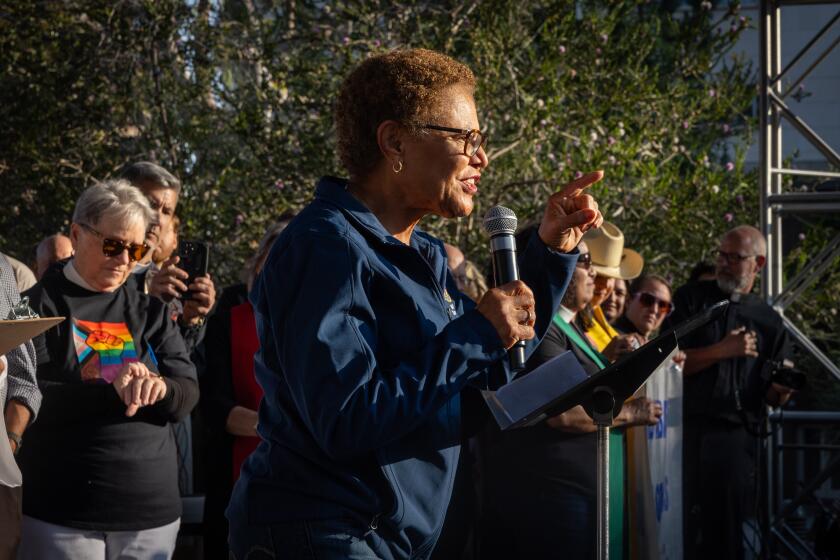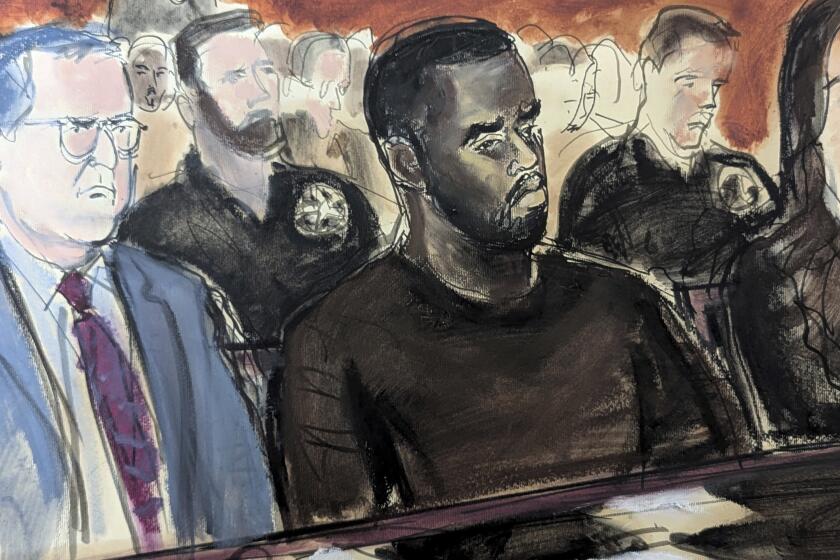THE RIOT’S AFTERMATH : Bankers Get Taken on a VIP Tour of L.A.’s Devastation : Recovery: The tour’s organizers hope to prod banks into lending to rebuild damaged neighborhoods.
- Share via
Call it a Gray Line-like tour of an inner-city meltdown.
Inside was hot coffee, doughnuts and a television set broadcasting the “Sally Jessy Raphael” talk show. Men in suits sat in plush, burgundy-colored seats, some of them talking on portable telephones as an air conditioner hummed. Traveling alongside, in front and behind were five Los Angeles Police Department cars, escorting about 40 sightseers in the two luxury buses. Two Los Angeles police officers were also aboard each bus.
This was the VIP tour of the riot devastation that Los Angeles-area bankers got Tuesday morning.
Aboard were vice presidents and senior vice presidents from such large institutions as City National Bank and Wells Fargo Bank, one of whom flew down from San Francisco just for the tour. Presidents of smaller institutions rode along. Los Angeles City Atty. James K. Hahn was there, as was sportscaster and actress Jayne Kennedy.
The organizers were Carlton Jenkins, managing partner of Founders National Bank, the only black-owned commercial bank in Los Angeles, and businessman John Bryant. Jenkins in particular has been outspoken in trying to prod banks into lending to rebuild.
Talking through a microphone, he was part tour guide, part community activist as he pleaded for banks to help and chided them for having so little presence in southern Los Angeles over the years.
“These were thriving mini-malls that disappeared within a matter of two days,” Jenkins said as the buses rode down Martin Luther King Jr. Boulevard. One relatively intact supermarket, he said, was spared thanks to either “the fire department or a short match.”
No firm commitments came out of the tour, but that wasn’t expected. Some banks have disclosed some charitable donations and immediate relief programs to help rebuilding. How big a long-term program there will be is still unclear.
Jenkins acknowledged that the route of the three-hour tour was to some extent designed for its shock value, something to show people exposed to the rioting only through CNN or local news stations. Moving nonstop through every traffic light, even red ones, the buses moved across Martin Luther King Jr. Boulevard, into the Crenshaw District, up Vermont Avenue with a brief drive by Koreatown. Block after block, youths in baseball caps and mothers with children stared curiously at the passing motorcade.
The bus passed the shell of a furniture store, but with the window intact advertising its “blowout sale.” One banker pointed out the juxtaposition of a charred liquor store on one side of Vermont with tranquil USC tennis courts on the other. Hahn noted that drug dealers his office had tried to clear out of an area off Olympic Boulevard were still hanging out in the parking lot of a charred shopping center.
Stops were made at shopping centers and burned-out blocks so the bankers could step between the twisted metal and some still-smoldering buildings that one week ago were thriving stores.
“You have to touch it, and feel it and smell it,” said David C. Lizarraga, chief executive of the parent company of Community Thrift & Loan in East Los Angeles.
At each stop, 10 or more police officers, some with weapons ready, stood guard. Some on the tour were uncomfortable with the level of police-required security, as if it further highlighted the gulf between the bankers and the people on the street.
“This gives the wrong impression. It’s overkill,” said Wells Fargo Senior Vice President Harold D. Lee. Added Julia M. Williams, director of business and finance for Lt. Gov. Leo McCarthy: “The message it sends is that you can’t go into the area without this kind of police escort.”
There also were constant reminders of the ongoing conflict between southern Los Angeles and the banking industry, which has long been accused of having too little presence in the area. There was a block-long line at a check-cashing store, one of the many that have flourished because so few banks provide the service. A Home Savings branch had a line half a block long at its automated teller. There were burned out shells of branches that did operate in the area, one that had been operated by Bank of America and another by Home Savings.
Throughout the tour, Jenkins criticized banks for having an inadequate “delivery system”--so few offices and branches--to get credit to people in southern Los Angeles who need it. Steven C. Hall, a senior vice president for Wells Fargo, acknowledged that the system is inadequate, but said the major banks are trying to improve it through a coalition working with city officials.
At one point, an angry man with two young daughters interrupted a stop on Vermont Avenue. He wasn’t part of the planned program, but wanted to make a few points in no particular order.
There were black-owned businesses in the area, he said, but “gangs stuck guns in their faces” and they left. The conflict in Los Angeles isn’t “a black-Korean” thing, he said. And social scientists should have seen it all coming, but didn’t. Having been heard, he led his daughters away.
More to Read
Sign up for Essential California
The most important California stories and recommendations in your inbox every morning.
You may occasionally receive promotional content from the Los Angeles Times.













